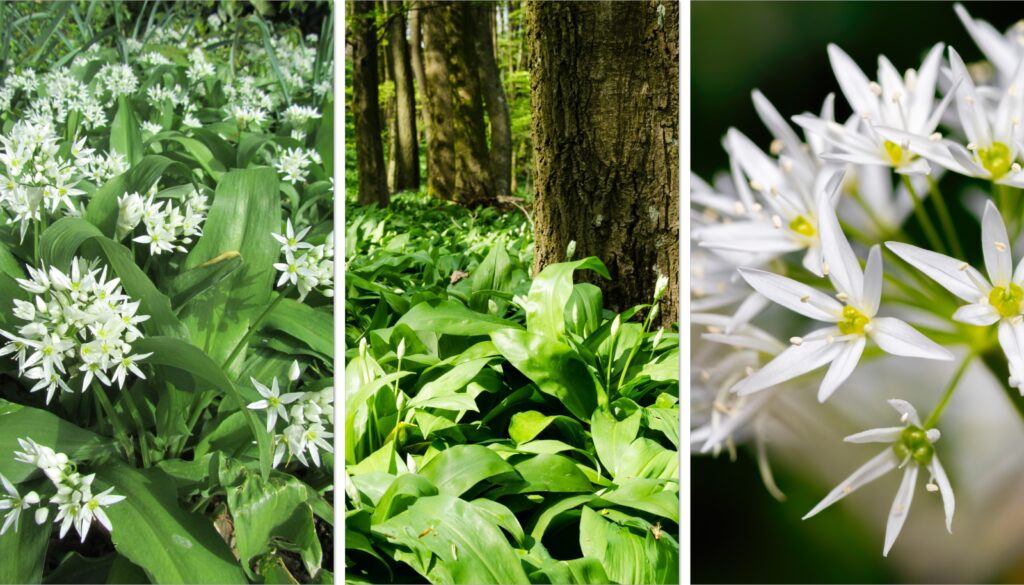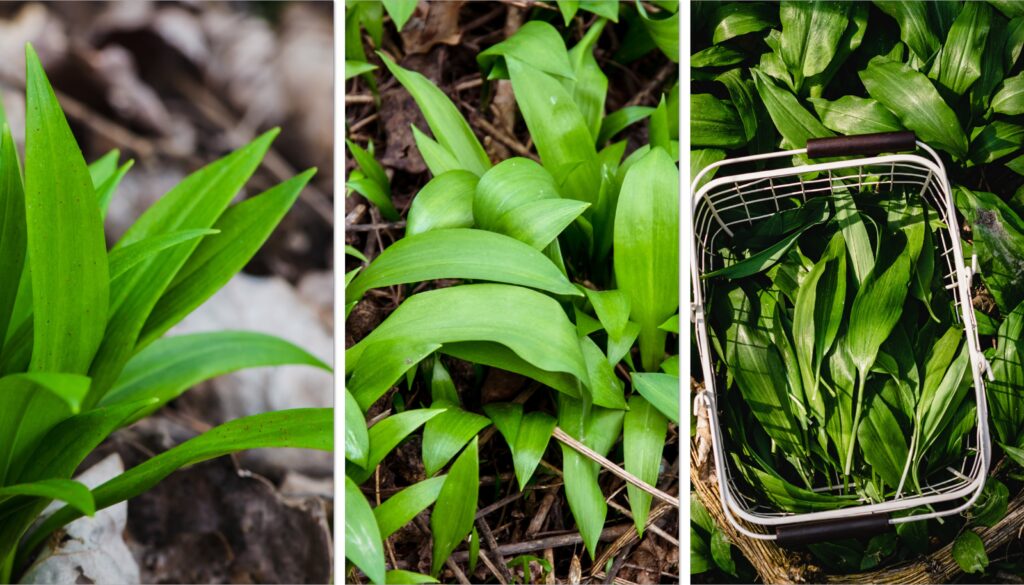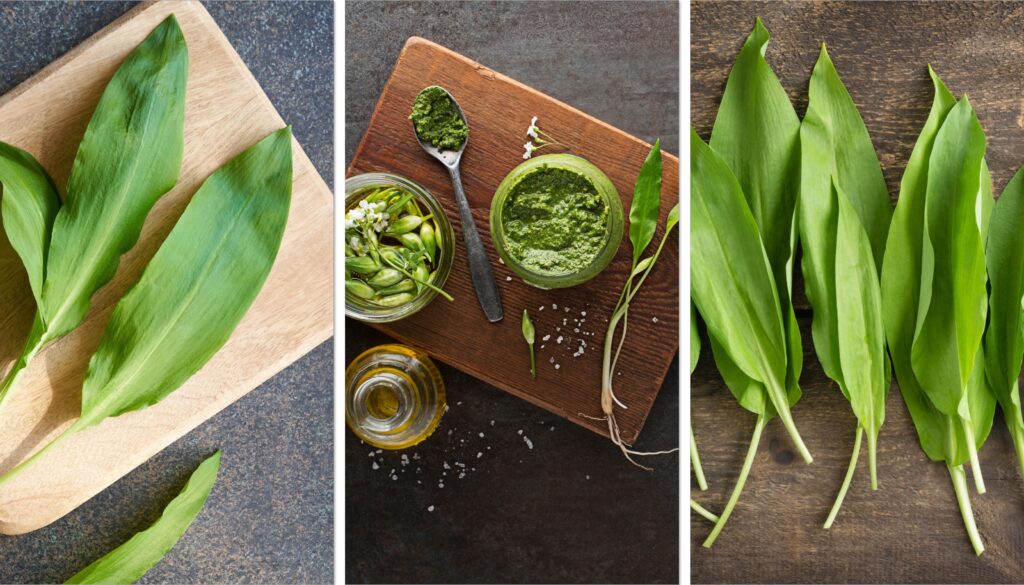Guest post blog by Katrina & Clayton
Wild garlic (Allium ursinum), also known as ramsons, is a native woodland plant in the UK that thrives naturally across Scotland’s damp, shaded landscapes. Its ability to grow under deciduous trees and in moist soils makes it perfectly adapted to Scotland’s cool, wet climate. In early spring, it emerges with lush green leaves, followed by clusters of star shaped white flowers in late April or May. This plant is perennial, meaning it returns year after year once established, spreading both through underground bulbs and by self seeding.
For gardeners in Scotland, wild garlic offers multiple advantages: it is hardy, low maintenance, and provides both aesthetic and culinary benefits. Its green carpets suppress weeds, its flowers attract pollinators, and its leaves provide an early season harvest at a time when few other crops are ready. Because it is naturally found in shaded areas, it is an excellent choice for underplanting beneath fruit trees or in corners of the garden where many other vegetables would struggle to thrive.
Planting Wild Garlic
The best time to plant wild garlic in Scotland is autumn, typically between October and November, when the soil is still workable but cool enough to encourage dormancy before winter. This mirrors its natural lifecycle, where bulbs lie dormant underground during the cold months before sprouting in early spring.
Wild garlic can be grown from bulbs or seeds. Bulbs provide faster establishment and will usually produce leaves the following spring, while seeds may take a year or more to germinate and mature. When planting bulbs, choose a shaded or partially shaded site, ideally under deciduous trees where they will receive filtered light in spring before the tree canopy thickens. Space bulbs approximately 10–15 cm apart and plant them about 5 cm deep. Water well after planting to help them settle into the soil.
If starting from seed, sow in autumn directly into the soil where you want them to grow. Wild garlic seeds require a period of cold stratification to germinate effectively, which Scotland’s winter provides naturally. Cover seeds lightly with soil, and be patient, as they may take several months to show signs of growth.

Managing Wild Garlic
Once the flowers fade, remove the spent flower heads before they set seed if you wish to control their spread. Cutting back flowering stems also encourages the plant to divert more energy into its bulbs rather than seed production, resulting in stronger growth in the following year. After midsummer, the foliage will yellow and collapse naturally, at this point, you can cut back dead leaves to keep the area tidy, though this is optional. Allowing the leaves to decompose in place will enrich the soil organically.
Dividing is the most effective way to propagate wild garlic and manage its spread. Every few years, mature clumps may become crowded, which can reduce leaf size and overall vigour. Dividing helps rejuvenate the plants and allows you to expand your crop to other areas of the garden.
To divide, wait until the plant’s foliage begins to die back in early summer or tackle the task in early autumn before new growth begins. Carefully dig up a clump, ensuring you lift the bulbs gently to avoid damage. Separate them by hand into smaller groups or individual bulbs. Replant them immediately at the same depth as before, spacing them adequately to give each bulb room to grow. Water well after replanting and mulch lightly to conserve soil moisture.
Caring for Wild Garlic
Wild garlic is naturally low maintenance because it is adapted to Scotland’s climate and soil conditions. Once established, it requires very little intervention. Watering is usually unnecessary in open ground because rainfall is sufficient, though container grown plants may need occasional watering during dry spells.
Mulching annually with leaf mould or compost mimics its woodland environment, enriches the soil, and helps retain moisture. Weed competition is minimal once wild garlic forms a dense carpet, but in its early stages, keep the area clear of invasive weeds that may stunt growth.
Because wild garlic is a native species, it rarely suffers from serious pests or diseases. However, slugs may occasionally nibble young leaves, particularly in wet springs.

Companion Planting with Wild Garlic
Wild garlic makes an excellent companion plant due to its ability to suppress weeds, attract beneficial insects, and deter certain pests. Its strong scent can help confuse or repel pests like aphids and carrot root flies, making it useful when planted near vulnerable crops.
It grows well beneath fruit trees, creating a living mulch that reduces weeds while adding biodiversity. Planting it near currants, gooseberries, or apple trees can also help attract pollinators in early spring when few other flowers are blooming. Avoid placing it near shallow rooted vegetables that need more light, as its dense growth may shade them out.
Edible Parts of the Wild Garlic Plant
Wild garlic is a versatile edible plant, with several parts suitable for culinary use:
Leaves: The most commonly harvested part, available from March to May. They have a mild garlic flavour and can be eaten raw in salads, blended into pestos, or used as a seasoning in soups, sauces, and stir-fries.
Flowers: These small, white star shaped blooms are also edible and make attractive garnishes. They have a slightly stronger flavour than the leaves.
Bulbs: While edible, bulbs are less commonly used because harvesting them reduces the plant’s ability to return the following year. If you do choose to eat bulbs, do so sparingly and only from areas where wild garlic is abundant and established.
Always ensure you identify wild garlic correctly, as its leaves resemble those of certain poisonous plants such as lily of the valley. The easiest way to confirm is by crushing a leaf gently wild garlic has a distinct garlic smell that toxic lookalikes do not share.

What Soil is Best for Wild Garlic
Wild garlic thrives in soil that mimics its natural woodland habitat: moist, fertile, and rich in organic matter. It prefers slightly acidic to neutral soils with a pH between 6.0 and 7.0. While it tolerates heavy Scottish rains well, it dislikes waterlogged conditions, so well drained soil is essential. Raised beds or adding organic matter such as leaf mould can improve drainage in heavier clay soils.
Mulching with leaves or compost each autumn helps maintain the rich, damp conditions wild garlic needs to flourish. Avoid very sandy soils unless they are improved with plenty of organic matter, as these dry out too quickly for the plant’s liking. Caledonian Green Goodness or Caledonian Kelpie Compost are both great for seasonal mulching.
Beyond its practical benefits, wild garlic offers a seasonal treat at a time when few other fresh ingredients are available. Its leaves, flowers and even bulbs can be used creatively in the kitchen, while its presence enriches the ecosystem by supporting pollinators and suppressing weeds. For gardeners in Scotland seeking hardy, multi purpose plants that require minimal input, wild garlic is a reliable and great choice.
Katrina & Clayton

Katrina & Clayton live with their family in East Ayrshire in Scotland and share their daily life in the garden on instagram @buildingfoodforest_scotland. They practice permaculture principles, reducing & repurposing waste whenever they can. Katrina shows how home educating in nature has helped Clayton thrive.
Clayton Completed The Grow and Learn Course with the Royal Caledonian Horticultural Society in 2022. This year he will be completing Level 2 Nurture Course. Clayton is 16, Autistic, Non Verbal & has been Home Educated for the last 6yrs. Both Katrina and husband Peter have studied the Permaculture Design Course PDC and PDC Pro over the last 5yrs, developing their garden from grass to an ongoing food forest.
They have featured on BBC Beechgrove Gardens, Gardeners World Magazine and write for Scotland Grows Magazine. Katrina has a series of children’s story books out following the life of Clayton in the garden. Available at Amazon.
See more and follow Katrina & Clayton at the links below:



